-
Product Name
MMP9 antibody
- Documents
-
Description
MMP9 Rabbit Polyclonal antibody. Positive IF detected in HeLa cells. Positive IHC detected in human breast cancer tissue, human cervical cancer tissue, human stomach cancer tissue. Positive WB detected in Jurkat cells, HepG2 cells, mouse heart tissue, NIH/3T3 cells, Raji cells, rat brain tissue, zebrafish tissue. Positive IP detected in Jurkat cells. Observed molecular weight by Western-blot: 67 kDa, 92 kDa
-
Tested applications
ELISA, WB, IHC, IP, IF
-
Species reactivity
Human, Mouse, Rat, Zebrafish; other species not tested.
-
Alternative names
92 kDa gelatinase antibody; 92 kDa type IV collagenase antibody; CLG4B antibody; Gelatinase B antibody; GELB antibody; Matrix metalloproteinase 9 antibody; MMP 9 antibody; MMP9 antibody
-
Isotype
Rabbit IgG
-
Preparation
This antibody was obtained by immunization of MMP9 recombinant protein (Accession Number: NM_004994). Purification method: Antigen affinity purified.
-
Clonality
Polyclonal
-
Formulation
PBS with 0.1% sodium azide and 50% glycerol pH 7.3.
-
Storage instructions
Store at -20℃. DO NOT ALIQUOT
-
Applications
Recommended Dilution:
WB: 1:200-1:2000
IP: 1:200-1:1000
IHC: 1:20-1:200
IF: 1:20-1:200
-
Validations
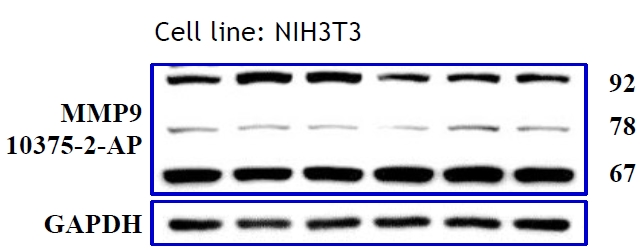
WB results of MMP9 antibody (Catalog No:112709, 1:500) with NIH3T3 cells, 92 kDa for pro-MMP9 and 78-82 kDa and 67 kDa for Active MMP9. Data from Dr. Hui-Wen Chiu, Taipei Medical University.
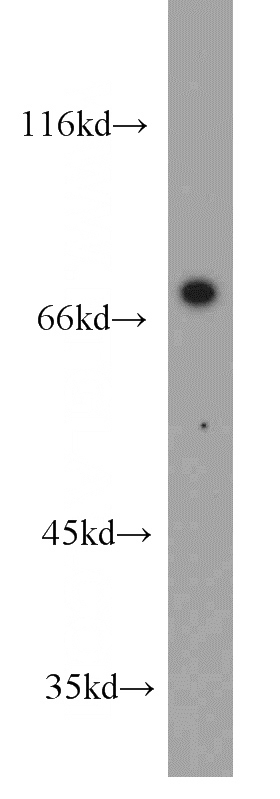
Jurkat cells were subjected to SDS PAGE followed by western blot with Catalog No:112709(MMP9 antibody) at dilution of 1:500
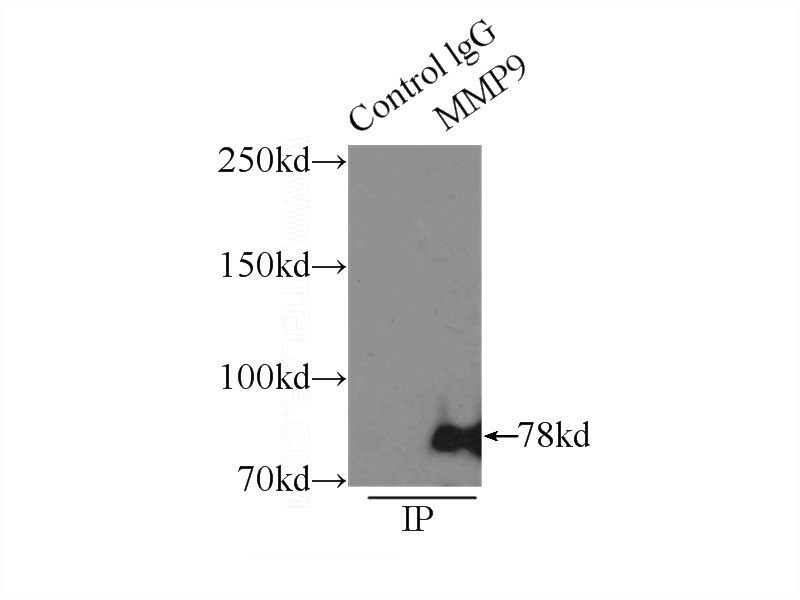
IP Result of anti-MMP9 (IP:Catalog No:112709, 3ug; Detection:Catalog No:112709 1:300) with Jurkat cells lysate 4000ug.
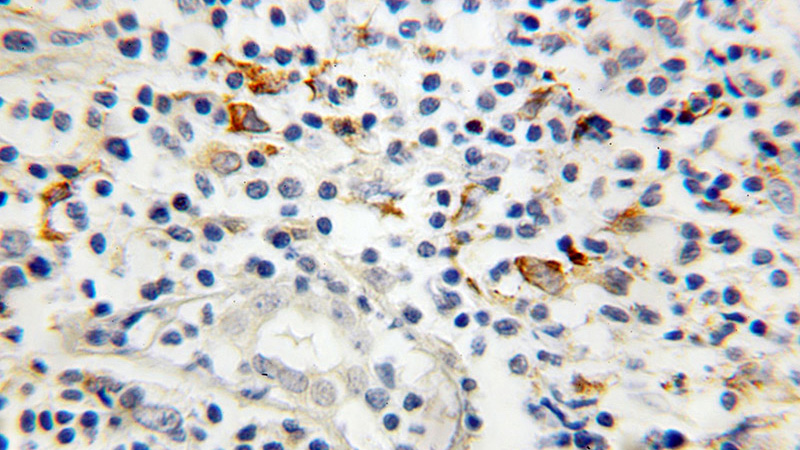
Immunohistochemical of paraffin-embedded human breast cancer using Catalog No:112709(MMP9 antibody) at dilution of 1:50 (under 40x lens)
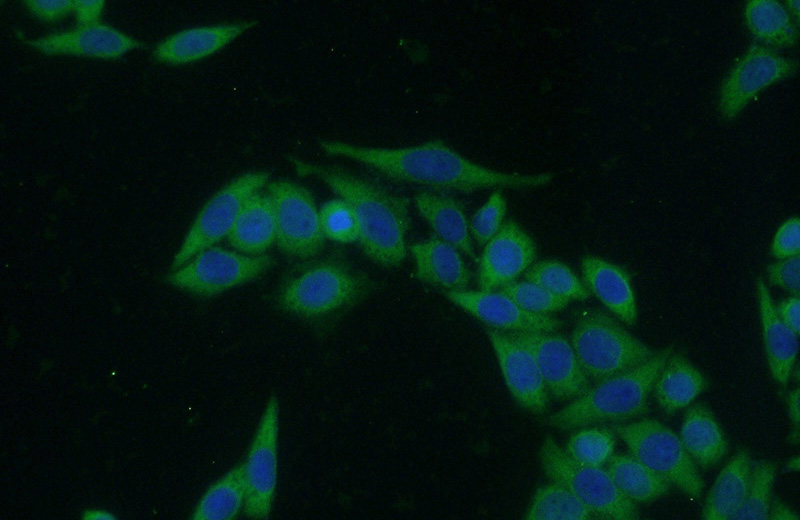
Immunofluorescent analysis of HeLa cells using Catalog No:112709(MMP9 Antibody) at dilution of 1:50 and Alexa Fluor 488-congugated AffiniPure Goat Anti-Rabbit IgG(H+L)
-
Background
Proteins of the matrix metalloproteinase (MMP) family are involved in the breakdown of extracellular matrix in normal physiological processes, such as embryonic development, reproduction, and tissue remodeling, as well as in disease processes, such as arthritis and metastasis. Most MMP's are secreted as inactive proproteins which are activated when cleaved by extracellular proteinases. Matrix metalloproteinase 9 (gelatinase B, 92kDa gelatinase, 92kDa type IV collagenase) (MMP9, synonyms: GELB, CLG4B) degrades type IV and V collagens. Studies in rhesus monkeys suggest that MMP9 is involved in IL-8-induced mobilization hematopoietic progenitor cells from bone marrow, and murine studies suggest a role in tumor-associated tissue remodeling. The pro-MMP9 is 92 kDa and it can be detected a processed form of 68 kDa or 82 kDa and this protein can exsit as a dimer of 180 kDa(PMID:7492685).
-
References
- Sakashita N, Motooka Y, Suganuma M. A case of pulmonary capillary hemangiomatosis with pulmonary fibrosis associated with MMP-9 related pulmonary remodeling. Pathology international. 61(5):306-12. 2011.
- Xu Z, Liu D, Fan C, Luan L, Zhang X, Wang E. DIXDC1 increases the invasion and migration ability of non-small-cell lung cancer cells via the PI3K-AKT/AP-1 pathway. Molecular carcinogenesis. 53(11):917-25. 2014.
- Zhang S, Qi Y, Xu Y. Protective effect of flavonoid-rich extract from Rosa laevigata Michx on cerebral ischemia-reperfusion injury through suppression of apoptosis and inflammation. Neurochemistry international. 63(5):522-32. 2013.
- Xiang M, Su H, Hu Y, Hu Y, Yang T, Shu G. Chemical composition of total flavonoids from Salvia chinensia Benth and their pro-apoptotic effect on hepatocellular carcinoma cells: potential roles of suppressing cellular NF-κB signaling. Food and chemical toxicology : an international journal published for the British Industrial Biological Research Association. 62:420-6. 2013.
- Li X, Huang T, Jiang G, Gong W, Qian H, Zou C. Proteasome inhibitor MG132 enhances TRAIL-induced apoptosis and inhibits invasion of human osteosarcoma OS732 cells. Biochemical and biophysical research communications. 439(2):179-86. 2013.
- Yi Y, Wu H, Gao Q. Interferon regulatory factor (IRF)-1 and IRF-2 are associated with prognosis and tumor invasion in HCC. Annals of surgical oncology. 20(1):267-76. 2013.
- Liu N, Li Y, Su S, Wang N, Wang H, Li J. Inhibition of cell migration by ouabain in the A549 human lung cancer cell line. Oncology letters. 6(2):475-479. 2013.
- Sang H, Li T, Li H, Liu J. Down-regulation of Gab1 inhibits cell proliferation and migration in hilar cholangiocarcinoma. PloS one. 8(11):e81347. 2013.
Related Products / Services
Please note: All products are "FOR RESEARCH USE ONLY AND ARE NOT INTENDED FOR DIAGNOSTIC OR THERAPEUTIC USE"
